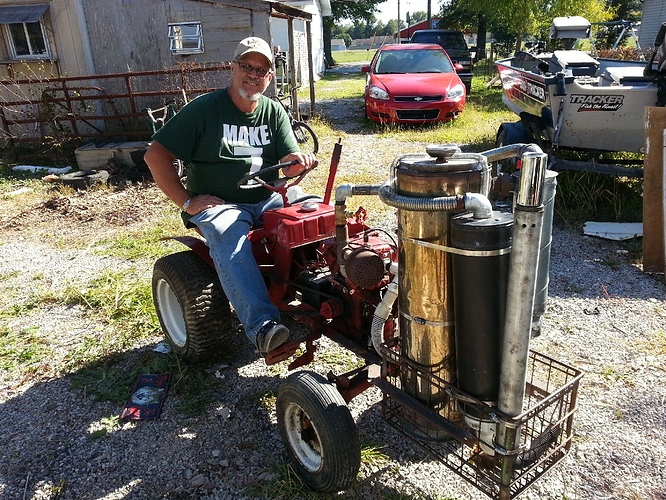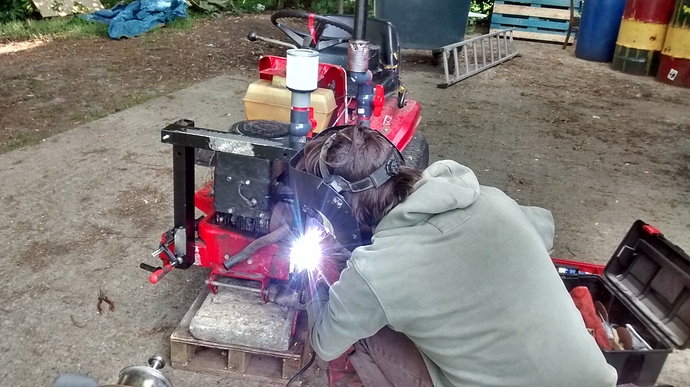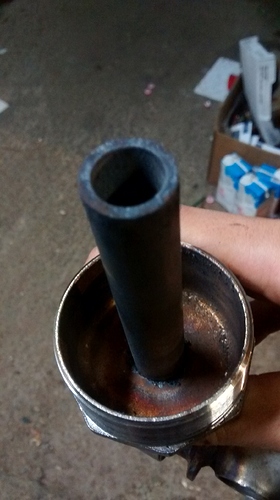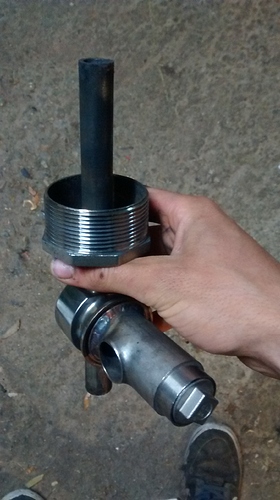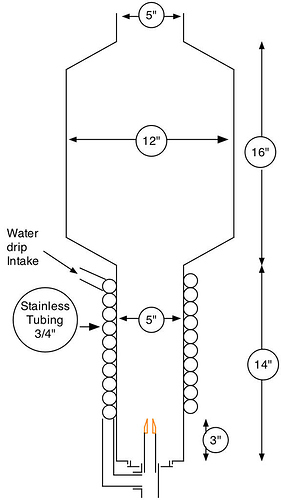OK Tom, I will never live that one down. I popped the clutch and just about went over backwards with the weight of my back mounted gasifier. Thankfully the bystanders were not laughing too hard to help me back down.  .
.
Yeah, that was funny
I’m happy you did that stunt before me 
Would you suggest putting it in front of the engine? I am worried about the heat of the reaction zone next to the engine.
Can I find a picture of your machine?
EDIT: I found your blogpost on the lawn tractor
I have always mounted mine on the front. That allows me to still use the trailer hitch. I think yours is much larger than any of mine. I use 12-20 gallon compressor tanks.
Hey Don, did you ever put the wheelie skids on the back?
Bob
Finally was able to get a moment for welding the reactor in place. It is mounted in a way that the reactor can be removed if needed. Me and a friend took it for a spin afterwards, and it went pretty good  . Sometimes had to adjust the a/f mixture while driving/idling.
. Sometimes had to adjust the a/f mixture while driving/idling.
Had to start it on gasoline and a piece of rope because the starter motor spring mechanism broke  . But in its place I have mounted a reed switch to calculate rpm (not ideal, still looking for a small hall sensor).
. But in its place I have mounted a reed switch to calculate rpm (not ideal, still looking for a small hall sensor).
I will post some close-ups soon and do an inspection on the nozzle.
It’s a great experience driving on wood 
-Senne
Okay I had a few nice drives on the riding mower. Already introduced 10 persons to driving on charcoal  . I am surprised about the lifespan of the fuel. I have taken the nozzle out for a quick look (15mm ss).
. I am surprised about the lifespan of the fuel. I have taken the nozzle out for a quick look (15mm ss).
All seems okay!
Still, I am wondering about making hydrogen gas. I already tried a few times to spray demineralised water against the reactor so the nozzle would suck in the steam (as Koen is demonstrating in one of his clips). I was doing full throttle to get lots of heat in the reaction zone but I could not confirm that hydrogen was made.
What are your recomendations to confirm water-gas shift reaction?
I do have a DHT22 sensor in the filter box. It is made to read air humidity and temperature but can only update every 2 seconds.
I also do have a suspicion on the leakiness of my pvc connections, maybe I’m not pulling hard enough on the nozzle to create the temperature (I can almost close the air intake valve when driving). Enough gas is made to drive the mower… so maybe that isn’t the problem.
-Senne
Well done Senne , that nozzle looks to be in pretty good shape what sort of run time have you on it so far ?
As for the air mixture valve , i have had the same happen to mine a few times ,i can almost shut the air valve off and engine keeps running and then a while later i have found air leaks in the system , so maybe try blowing back through the system with a fan and squirt some soapy water everywhere ,that normal works for me tracing the leaks .
Dave
I have gone trough half a hopper. A few hours, it’s hard to say because the hype messes with your time experience 
Hi Senne,
Just in case you haven’t found a Hall sensor yet. I’ve used the UGN3130 with the LM2907 to build a tach. Works well with a d’Arsonval movement.
Best,
Rindert
Hi Senne.
Awesome builds . I love the simplicity.
Could you perhaps post the link where you got the plans/idea for your gasifier and tlud?
Id like to build something similar as it seems like it could work in our African conditions.
Good work senne. It truly is a bucket of lemons too slow up the hype of first time driveing with wood or charco from wood, first times around and as you tinker and modifi we find more changes as doing, drive ing on wood CONGRADULATIONS. AllWays a good skill too know and have the option too use for tranportation as the skills. Or the operator learning curve as Wayne puts it driveing on wood is 25 Percent machine and 75 percent operator learning inproves.
Your nozzle looks like new. Mine get melted rather quickly unless exhaust gas is used to cool the oxidation zone. As you note, there are probably some air leaks. It doesn’t even have to be much. A few cracks in the pipe or poorly fitted lid. But you have a machine running on charcoal so Yippee! Now you start fine tuning the system and having fun.
Gary in PA
I used Koen’s small farmer model. Mine is slightly narrower in the cylinder and the hopper. Did not yet installed water drip.
The gas tube is 2 inches diameter. Pvc piping is 4cm (1.5 inches).
My guess for the intact nozzle is CO2 reduction from the exhaust. Note that the exhaust is in the front of the mower and very close to the air inlet.
-Senne
Had been a while since the riding mower drove on char. I was playing around with some injection ideas. I was experimenting with creating high energy gas by injecting some methanol trough the nozzle. At first it didn’t work out because my air intake was to cold to vaporize the methanol so I set it on fire inside the air intake (picture of the nozzle and air intake in post 48).
I was closely observing the governor mechanism. I have always observed that the governor is wiggling way more when driving on gasoline and holds more steady on chargas. This is because of the energy of the fuel I suppose. When methanol was burning inside the air intake, hot water vapor and CO2 were produced right before the charcoal combustion at the tip of the nozzle. The governor started wiggling like on gasoline. I was confident that I had made some stronger gas. The filter was clean and dry afterwards.
I had done some research and it seemed like a mix of methanol and water where a good combination for injection because of the melting temperature of methanol and the fact that it holds an oxygen atom in a small molecule and is combustible. This means more oxygen without nitrogen gas.
But maybe this is a waste of the original energy of methanol? Any ideas?
Hi Senne, Have you allready tried blending in some exhaust gas from the engine? I think it should give richer gas, but probably not as rich as water/methanol mix.
Hi Senne,
I’m not a Chemist (and too lazy to do some in dept research about that  ), but a good idea and it sounds that you made more powerful gas.
), but a good idea and it sounds that you made more powerful gas.
I guess due to energy conservation, you may only equal the amount of energy of methanol in the gas. With some unavoidable losses it is probably less than adding it after the gasifier to burn in the engine directly.
On the other hand, the extra oxygen and its ability to burn in the gasifier inlet, thus bringing extra heat in the reaction, is definitely beneficial for the gasification.
Rindert, adding exhaust gas in the gasifier does not result in richer gas but in a better heat economy (you burn less char for the same result), as you recycle some of the CO2 instead of burning fresh char and wasting heat. But for richer gas, you have to create hydrogen. But in the exhaust gases from dry charcoal gas (no water added) are just traces of water vapor, so this is not the way to create more powerful gas than with just plan air.
This is just theory, in practice some other effects may give slightly different results, but in general you have to produce more hydrogen for more power.
Regards,
Til
Hi Rindert,
From what I have read and understand, EGR only serves to cool the reaction zone and reduce carbon consumption.
The exaust gasses contain an equal percentage of nitrogen gas per volume and the same or no amount of water (-> hydrogen gas contains more energy per volume).
To make stronger gas, you need to try and create hydrogen gas, and try to bring in oxygen other than oxygen from the air (because oxygen from the air comes with 4 times the amount of inert nitrogen gas taking up a lot of volume in the piston), and try to get the gas as cool as you can before entering the piston.
-Senne
This obviously isn’t the best manner for economic driving, but maybe nice as a boost when you need the power… I will try to do some more research on the energy loss of methanol.
A benefit of cracking the methanol is that you don’t have to deal with the corrosive properties of methanol inside the engine.
To my chemical knowledge it seems like the right amount of water mixed with methanol is able to make the most dense gas you can make in a charcoal gasifier (more dense than woodgas in my calculations).
For those who are interested, I made an excel file with some chemical calculations on gas composition when injecting combustibles.
-Senne
